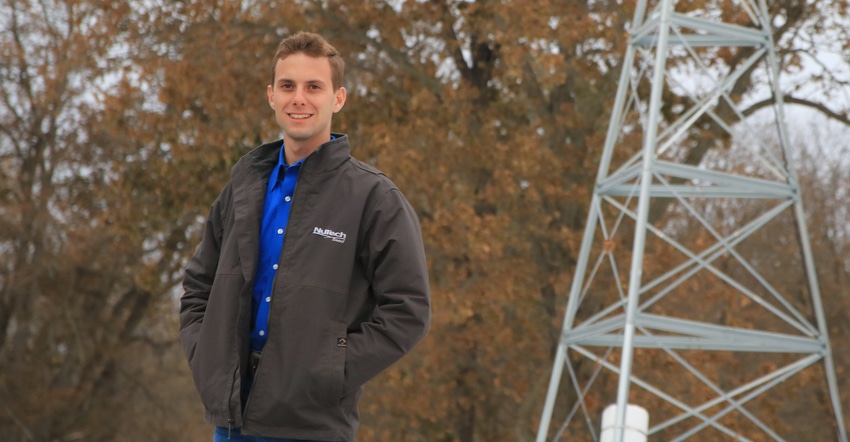
Young farmer Clint Gorden of Blue Mound, Ill., was hard at work over Christmas Eve, crunching numbers from his first growing season and readying paperwork for a threefold increase in the acreage he rents for 2020.
Gorden was a seed sales intern with Pfister Seeds in 2015 and started his position as territory sales rep for NuTech Seed in the spring of 2018, after earning his degree in agronomy management from Illinois State University. He always planned to farm, but his plans were sped up by an opportunity in the fall of ’18 to farm 210 acres of his family’s ground.
“My dad’s dad passed away when I was really little, but I can remember riding with him in the combine,” Gorden says. “So the passion was there and something was going to happen. It was just a matter of when.” He’ll triple his acreage in 2020, adding another 390 acres of rented ground that a retiring neighbor asked him to take on.
“Being involved in agribusiness, I didn’t want to be the guy going around seeking ground from my customers, so to speak. I just got lucky and someone came to me,” he says.
Gorden took a job in sales for Advanced Ag Services two years ago as well, and his boss, Scott Brockelsby, along with Scott’s cousin Bryce Brockelsby, help out by renting him a planter and other equipment.
“There’s a few guys I can’t thank enough. I worked for a guy during high school, and I still talk to him all the time. He farms quite a bit. I feel like part of the family. And between him, Scott, my dad, friends and some of my customers, I’m pretty fortunate to have a good support system and people to bounce ideas off of,” Gorden says.
Turning a profit
In a tough 2019 crop year, Gorden turned a profit, despite spending money on inputs like insecticide. Facing wet conditions, he also applied anhydrous ammonia at planting and sidedressed a little over half of his fertilizer later in the season.
“The corn was tall in one of the fields and bent a little under the applicator, but we just made it work. I know sidedressing definitely paid off because we just had too much water,” Gorden says.
His first growing season featured non-GMO soybeans and corn, as well as some Enlist beans. He was able to control weed pressure on the non-GMO crops, and he plans to grow more Enlist beans in 2020 because the program worked so well.
“I planted non-GMO corn and beans this year and didn’t think twice. I wasn’t afraid to try something different,” Gorden says. “The thing with non-GMO corn is that your neighbors might just assume they can spray next to it and it’s going to be fine, but if they have a trace of Roundup, the corn is done for.”
Gorden isn’t opposed to non-GMO corn in the future, but says he has more hybrid options with traited corn. He’s still going to grow non-GMO soybeans because the premium helps as he leaps with both feet into an era of agriculture with low grain prices.
“Some colleagues kind of look at me like I’m a nut. I sold everything over the scales if I didn’t already have it sold this fall, because I can’t pay storage. It doesn’t pencil out for me,” Gorden says. “I’m messing with puts and calls and seeking help on that. And when you’re my size, that non-GMO bean premium really helps turn a profit.”

SALESMAN: In addition to farming, Clint Gorden is a salesman for NuTech Seed and Advanced Ag Services.

Starting out with no capital, Gorden knew when he went to Farm Credit Illinois for a loan, he would have to show how he could turn a profit and make farming work for his situation.
“I knew I had to be efficiently productive with what I was going to do. That’s why I look toward alternative tillage methods, the Maximum Farming System [by Ag Spectrum] and other management ideas to gain efficiency to get the most out of the crops, my time and my dollar,” Gorden says.
Getting covered
Gorden planted cover crops on 40 acres of minimally tilled land ahead of the 2020 growing season thanks to the Environmental Quality Incentives Program, or EQIP. With his new acreage, he plans to enroll more ground in the program, which helps him recoup cover crop seed expenses while simultaneously improving soil health.
“I’ve been associated with Ag Spectrum for two years now, and the more and more meetings I go to, the more agronomists I talk to, the more interest I get in cover crops and soil health,” Gorden says, adding he had a canola and cereal rye mix flown on the field, which will be planted with soybeans in 2020.
Ahead of corn next year, he plans to seed hairy vetch instead of cereal rye to avoid a carbon penalty. He’s also looking to eventually plant his soybeans “green” into stands of cover crops to help fight weed pressure. By applying a full load of residuals when killing the cover, he wants to see if a follow-up pass of herbicide later in the season will be necessary.
“Will I have to come back? I don’t know. If I don’t have to, that’s making me money, but we’re going to find out,” Gorden says. “If everyone’s getting 250-bushel corn and prices are at $3.50, I’m going to have to find some way to save money. That’s why looking into things like strip till or just running the vertical till with one pass in the fall or spring interests me.”
Gorden is a member of the Cultivating Master Farmers program, a two-year schedule of gatherings between young farmers and Master Farmer award recipients sponsored by Farm Credit Illinois, Compeer Financial, Illinois Farm Bureau, Growmark, Bayer and Prairie Farmer.
Read more about:
Cultivating Master FarmersAbout the Author(s)
You May Also Like




